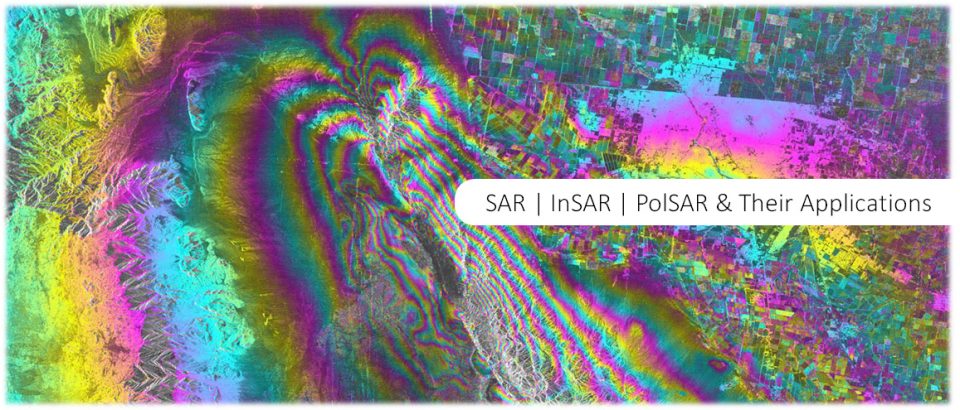
In this final module of the class, you will be learning of a range of applications that can be supported by SAR data. Single image applications will be the focus of early lectures while later segments will focus more and more on time-series analysis methods. Due to the wealth of regularly observed data that is produced by recent and future SAR sensors (e.g., Sentinel-1 and NISAR), this latter piece is rapidly gaining importance. Please follow the lectures and labs and expand your knowledge by adding in further readings as suggested below.
Side Topic: AI4EO – Artificial Intelligence in Earth Observation
Synopsis:
This is a guest lecture on the methods of Deep Learning in Earth Observation given by Prof. Dr. -Ing. habil. Xiaoxiang Zhu, Professor for Signal Processing in Earth Observation at the Technical University of Munich and Head of Department “EO Data Science” at the German Aerospace Center (DLR). In her lecture, she will summarize the latest methods in deep learning including the concepts of Convolutional Neural Networks (CNNs), Recurrent Neural Networks (RNNs), and Generative Adversarial Neural Networks (GANs).
Preparatory Reading:
To prepare for this lecture, please read the following paper in “Deep Learning in Remote Sensing” by Xiaoxing Zhu et al. It will provide you with an overview of the necessary background for this lecture.
Here the lecture notes for the 2019 installment of this class:
A live recording of a 2019 lab related to this topic can be found here.
Lecture 15: The Concepts of InSAR Time Series Analysis & The PS-InSAR Technique
Synopsis:
With this lecture we will return to the topic of InSAR. After learning about the limitations of pairwise InSAR processing in Lecture 13, this session will introduce you to advanced processing techniques designed to overcome these limitations. Specifically, we will talk about InSAR Time-Series Analysis techniques, which analyze not only one but many interferograms with the goal to reduce estimation noise and mitigate nuisance parameters.
After an initial introduction of the general concepts of InSAR time-series analysis, we will discuss the so-called Persistent Scatterer InSAR (PSI) approach. You will learn about the general idea behind PSI and understand its processing workflow. We will exemplify the accuracy of PSI-derived surface deformation estimates and look at a range of examples that successfully applied PSI for the mapping of surface motion across large spatial scales.
Preparatory Reading:
In preparation for this lecture, please read (Ferretti et al, 2001), which introduced the PSI approach for the first time. Additional reading should also include Ferretti, A. (2014); Satellite InSAR Data: Reservoir Monitoring from Space. This book by Alessandro Ferretti is an excellent introduction to modern InSAR Time-Series Analysis techniques.
A version optimized for note-taking can be found here. A 2023 live recording of this lecture is available here.
Lecture 16: The SBAS (Short BAseline Subset) Approach to InSAR Time Series Analysis
Synopsis:
PS-InSAR is a great technique for monitoring surface deformation in areas with sufficient density of high amplitude point-like scatterers. These are mostly available in and around urbanized environments, providing the basis for long term deformation measurements at the mm/year accuracy level. Outside of urban centers, however, the lack of persistent scatterers renders PS-InSAR suboptimal and other InSAR time series analysis techniques are preferred.
In this lecture we will be discussing Short BAseline Subset (SBAS) InSAR, an alternative time series technique with better performance in natural environments. We will discuss the principles and processing strategies of SBAS and look at some of the relevant applications of this technique. Toward the end of the lecture, you will also hear about available public domain software for PS- and SBAS InSAR processing.
Preparatory Reading:
In preparation for this lecture, please read (Berardino et al., 2002), which introduced the SBAS InSAR approach for the first time. Additional reading should also include (Lanari et al., 2004) and Ferretti, A. (2014); Satellite InSAR Data: Reservoir Monitoring from Space. The latter is a book by Alessandro Ferretti that provides an excellent introduction to modern InSAR Time-Series Analysis techniques.
A version optimized for note-taking can be found here. A 2023 live recording of this lecture is available here.


Lecture 17: Surface Water Mapping Using SAR
Synopsis:
The weather and illumination independence of SAR combined with the specific radar signature of standing surface water, make spaceborne SAR sensors excellently suited for monitoring weather-related hazard events such as flooding.
This lecture will demonstrate the application of SAR for surface water mapping. specifically in the context of hazard monitoring. After an initial introduction to the SAR signatures of surface water features, a single image thresholding approach will be introduced that shows high performance in the mapping of flood extents on large spatial scales.
A version optimized for note-taking can be found here. A 2023 live recording of this lecture is available here.
The University of Alaska Fairbanks is an AA/EO employer and educational institution and prohibits illegal discrimination against any individual: Learn more about UA’s notice of nondiscrimination.
